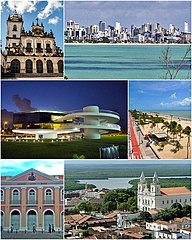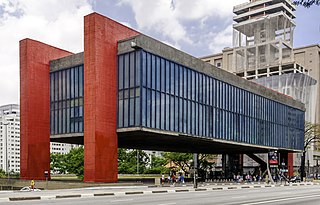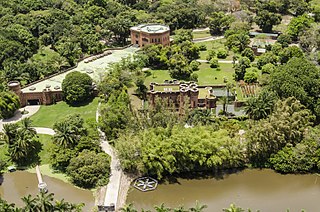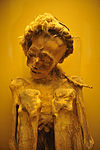
João Pessoa is the capital of the state of Paraíba in Brazil. Known as the "Brazilian Paris", due its abundance of green area, it was founded in 1585 and it is also known as the city where the sun rises first, because it is the easternmost city in the Americas at 34° 47′ 38″ W, 7° 9′ 28″ S. Its easternmost point is known as Ponta do Seixas. The city is often referred as "the second greenest in the world", with more than 7 square kilometres (2.7 sq mi) of forested land, second only to Paris, France, though such claim seems to be just a publicity stunt from the then mayor during Earth Summit.

The São Paulo Museum of Art is an art museum located on Paulista Avenue in the city of São Paulo, Brazil. It is well known for its headquarters, a 1968 concrete and glass structure designed by Lina Bo Bardi, whose main body is supported by two lateral beams over a 74 metres (243 ft) freestanding space, considered a landmark of the city and a main symbol of modern Brazilian architecture.
The Brazil women's national football team represents Brazil in women's association football and is run by the Brazilian Football Confederation (CBF). It has participated in eight editions of the FIFA Women's World Cup, finishing as runner-up in 2007, and seven editions of the Copa América Femenina.

The Ricardo Brennand Institute is a cultural institution located in the city of Recife, Brazil. It is a not-for-profit private organization, inaugurated in 2002 by the Brazilian collector and businessman Ricardo Brennand. It comprises a museum, an art gallery, a library and a large park.

The National Historical Museum of Brazil, was created in 1922, and possesses over 287,000 items, including the largest numismatic collection of Latin America. The architectural complex that houses the museum was built in 1603 as the St. James of Mercy Fort; earlier structures date back to 1567, erected by order of King Sebastian I of Portugal. In 1693, the Calaboose Prison, for slaves, was built. In 1762, the Casa do Trem was added as a depot of weapons and ammunition. The last additions are the War Arsenal (1764) and the Barracks (1835).

The Museu Nacional de Belas Artes is a national art museum located in the city of Rio de Janeiro, Brazil. The museum, officially established in 1937 by the initiative of education minister Gustavo Capanema, was inaugurated in 1938 by President Getúlio Vargas. The museum collection, on the other hand, takes its rise in the transfer of the Portuguese Court to Brazil in the early 19th century, when King John VI brought along with him part of the Portuguese Royal Collection. This art collection stayed in Brazil after the King's return to Europe and became the core collection of the National School of Fine Arts. When the museum was created in 1937, it became the heir not only the National School collection, but also of its headquarters, a 1908 eclectic style building projected by Spanish architect Adolfo Morales de los Ríos.

The Quinta da Boa Vista is a public park of great historical importance in the city of Rio de Janeiro, Brazil. The park was part of the gardens of the São Cristóvão Palace, the residence of the Emperors of Brazil in the 19th century.

Luzia Woman is the name for an Upper Paleolithic period skeleton of a Paleo-Indian woman who was found in a cave in Brazil. Some archaeologists believed the young woman may have been part of the first wave of immigrants to South America. The 11,500-year-old skeleton was found in a grotto in Lapa Vermelha, Pedro Leopoldo, Great Belo Horizonte, Brazil, in 1974 by archaeologist Annette Laming-Emperaire. The nickname "Luzia" pays homage to the Australopithecus fossil "Lucy". The fossil was kept at the National Museum of Brazil, where it was shown to the public until it was fragmented during a fire that destroyed the museum on September 2, 2018. On October 19, 2018, it was announced that most of Luzia's remains were identified from the Museu Nacional debris, which allowed them to rebuild part of her skeleton.

The National Archives of Brazil were created in 1838 as the Imperial Public Archives. The Archives were renamed in 1911, and are located in Rio de Janeiro, Brazil. The National Archives of Brazil is the Brazilian institution responsible for the management, preservation and dissemination of federal government documents. Since 2011 it is subordinated to the Ministry of Justice and Public Security.

Paço de São Cristóvão was an imperial palace located in the Quinta da Boa Vista park in the Imperial Neighbourhood of São Cristóvão, Rio de Janeiro, Brazil. It served as residence to the Portuguese Royal Family and later to the Brazilian Imperial Family until 1889, when the country became a republic through a coup d'état deposing Emperor Pedro II. Then, the palace briefly served as a public building by the provisional government for the constituent assembly of the first republican constitution. It housed the major part (92.5%) of the collection of the National Museum of Brazil, which, together with the building, were largely destroyed by a fire on 2 September 2018.
The Angra dos Reis meteorite is the type specimen of the angrite group. It was observed when it fell to earth in 1869.

The Museum of Tomorrow is a science museum in the city of Rio de Janeiro, Brazil. It was designed by Spanish neofuturistic architect Santiago Calatrava, and built next to the waterfront at Pier Maua. Its construction was supported by the Roberto Marinho Foundation and cost approximately 230 million reais. The building was opened on December 17, 2015, with President Dilma Rousseff in attendance.

Edgar Roquette-Pinto was a Brazilian writer, ethnologist, anthropologist and physician. He was a member of the Academia Brasileira de Letras and is regarded as the father of radio broadcasting in Brazil.

The Bendegó Meteorite is a meteorite found in the interior of the state of Bahia, Brazil. It is the biggest iron meteorite ever found in Brazilian soil, weighting 5,360 kilograms (11,820 lb). It has been on display at the National Museum of Brazil, in Rio de Janeiro, since 1888.

The National Museum of Brazil collections include an exhibition of meteorites discovered in Brazil and other countries.

The National Museum of Brazil collections include an exhibition of funerary steles from Ancient Egypt.

The National Museum of Rio de Janeiro collections include an exhibition of Mediterranean antiquities from Etruscan, Greek (Italiote) and Roman civilizations.

The National Museum of Brazil collections included an exhibition of fossils.

The Werner Collection is one of the collections on display at the National Museum of Brazil, in Rio de Janeiro. The collection gathers around 60 rare minerals obtained in the 18th century from the Freiberg Mining Academy, Germany, by the Portuguese nobleman António de Araújo e Azevedo. The name of the collection is due to the main researcher of the German academy, scientist Abraham Gottlob Werner. The collection came to Brazil in the 19th century, brought by the Royal Family, who was escaping from the Napoleonic invasion, and was initially sent to the Royal Military Academy, being moved to the Royal Museum in 1819. It is considered that it was the first collection to compose the National Museum.







































